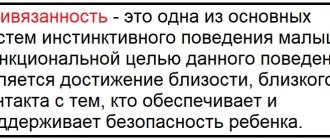Researchers of human nature and psyche have discovered an interesting fact, which states that at certain moments in life, specific qualities and traits are formed in the human personality. It is important to note that the appearance of certain mental abilities depends on the person’s age. It is this phenomenon that underlies the phenomenon of sensitive periods. In this article, we will talk about sensitive periods and their features.
Sensitivity is the optimal combination of conditions for the development of mental processes inherent in a certain age period
Sensitive period of speech development: from 0 to 6 years
From 0 to one year
The child imitates sounds and shows a very great interest in speech and emotional communication with adults. At this age, he really wants to talk, but he can’t do it yet. If the baby was deprived of warm emotional contact (primarily with the mother) - for example, like children in orphanages, this, alas, is an irreparable loss, and the entire process of the baby’s further development will be disrupted.
From one to three years
At this age, the baby masters oral speech (it is known that if for some reason he was deprived of human society and human speech, he will never learn to speak normally, like, for example, Mowgli children). With tremendous speed, a child increases his vocabulary - this is the most intensive increase in vocabulary in a person’s life.
This is the period when the baby is most sensitive to language norms. That is why Montessori does not advise adults to coo with the baby; they need to speak to him clearly and clearly - now this is the brightest role model.
Three to six
After three years, the child develops an interest in letters and writing. With great enthusiasm he tries to write this or that letter. And, by the way, not necessarily with pen and paper. Children enjoy laying out letters from sticks and wire, sculpting them from plasticine or writing with their fingers in the sand. At the age of about five years, most children show an interest in reading; at five years old, it is easiest to teach a child to read, as if he is waiting for it.
Oddly enough, learning to read is more difficult than writing. Therefore, Montessori advises approaching reading through writing. After all, writing is an expression of one’s thoughts and desires, and reading is an understanding of other people’s thoughts, solving some “alien” problem.
Sensitive period for the perception of order: from 0 to 3 years
Order for a child is not quite the same as order for an adult. The fact that things are in their places, that clothes are waiting for him every morning, neatly folded on a high chair, that every day follows a certain routine - the baby sees the stability of the world. External order thus turns into internal order.
Sometimes adults believe that children between two and two and a half years old can be unbearably capricious (some even talk about a two-year-old crisis). But it seems that these are not so much whims as a requirement to maintain order. And if this order is violated, it unsettles the little man.
There must be order in everything: in the environment, in time (every day passes in a certain rhythm), in the behavior of adults (they act according to certain rules that do not change depending on mood and weather).
Critical and sensitive periods
The ability of the nervous system to transform under the influence of external factors is transient. And it coincides with a period of more enhanced morphofunctional maturation, which can be explained by the phenomenon of age-related sensitivity to environmental influences, with which sensitive and critical stages of development are interconnected.
Each of the stages has a number of characteristic features, although their basis is a temporary increase in sensitivity to certain external influences. Characteristic features: level of selectivity to perception, time schedule, consequences of inadequate implementation, reversibility of outcomes.
Initially, the concept of a critical period was used in embryology to designate periods of time that are characterized by high sensitivity to the influence of factors that go beyond physiological norms.
During the period of intrauterine formation, in its clearly defined stages, each organ undergoes certain critical phases of differentiation.
A critical period should be called a period when the body must feel normative influences, and this will be a condition for its future full development. All transformations that occur during the critical phase are characterized by irreversibility, as a result of which the function and structure acquire a complete form, which becomes insensitive to modifying influences at a later age. Critical phases are more typical for anatomical and morphological transformations in the process of formation. Since they are associated with a specific stage of morphological development, they may represent chronological symmetry of development.
The concept sensitive denotes a period of time characterized by a certain set of stimuli that have a greater impact on the formation of functions than before or after. In fact, such a period is considered as more favorable for development. In other words, the critical period means action “now or never,” and the sensitive period means “it’s possible at another time, but it’s better now.”
Sensitive and critical periods determine the mechanism of individualization of formation, since depending on the implementation of a certain period, subsequent stages can receive an increasingly more characteristic experience, characteristic only of a given subject.
Due to the fact that the individuality of the subject at the entire stage of ontogenetic development is holistic, we can conclude that crises are systemic in nature and “include” significant physiological transformations as an invisible force.
Sensitive period for sensory development: from 0 to 5.5 years
At this age, the ability to see, hear, smell, taste, etc. is trained. This, of course, happens naturally, but for more intense sensory development M. Montessori recommends special exercises: for example, with your eyes closed, determine the taste, smell, size.
The child should have as many sensory impressions as possible. And for this it is not at all necessary to take the baby to the theater or to a symphony music concert every day. You can, for example, guess how various household items sound (listen, for example, to how a glass rings when you lightly tap it with a chopstick or spoon, and how an iron pan or a wooden table will behave in the same situation).
Children at this age (and adults too) really like the game “Magic Bag”. A variety of small objects are placed in a bag made of opaque fabric: scraps of various fabrics (from chiffon to tarpaulin), figures made of wood, plastic, metal, pieces of paper (from tissue paper to sandpaper), etc., and then we determine by touch what managed to find it in the bag.
Sensitivity
At the very beginning, a few words about what sensitivity is. Translated from Latin, “sensus” is a feeling, a person’s ability to perceive the world around him, to distinguish and respond to external stimuli. A person may have increased sensitivity or decreased sensitivity. The formation of this feature is influenced by:
- education and self-education;
- environment;
- heredity;
- diseases of the nervous system;
- age.
All these factors will play a big role in development. Different levels of sensitivity and perception of the world throughout a person’s life give the right to divide the process of formation of an individual’s personality into certain periods. In humans, there are critical and sensitive periods of development. Knowing about such moments and their features means helping to overcome the difficulties that arise in a child at a certain time. This will also help prevent the appearance of deviations in mental and physical development.
Sensitive period for the perception of small objects: from 1.5 to 5.5 years
Adults are horrified to see how little children manipulate peas or small buttons. Especially when they are trying to figure out whether said objects will fit in the ear or nose. Of course, such games should only be played under adult supervision.
But this is a completely natural interest that stimulates the development of fine motor skills of the fingers, the benefits of which cannot be doubted. Therefore, take care to make handling small objects safe. For example, buttons can be strung on a strong thread to create original beads that will keep your baby occupied for a long time. Together with you, he can take a long time to disassemble and reassemble the construction set with small parts. This activity helps to solve the problem of the whole and the part for the baby.
M. Montessori even advised creating special collections of small objects.
Sensitive period of movements and actions: from 1 to 4 years
An extremely important activity for a baby. Thanks to the movement, the blood is saturated with oxygen, and the oxygenated blood supplies the brain cells that are involved in the development of all mental functions. And therefore, any class-lesson system, long lessons at desks for children at this age is simply a crime against their nature.
Every year the child improves the coordination of his movements, masters new actions and learns to sense his body more and more accurately. Help him with this! Running, jumping on one leg, climbing ladders and balancing on a log are activities no less important than learning to write and count.
Sensitive periods of physical development
The formation of movements in children occurs in a prescribed sequence. In order to perform any movement, you need to show certain physical qualities, have speed and dexterity, and expend some strength. Therefore, along with the development of the main movements, the formation of physical qualities also occurs. The degree of development of physical qualities determines the quality and quantity of movements that the baby has.
Physical qualities are characterized by uneven development at different periods of children's lives. At one time, certain qualities are formed equally quickly and synchronously, at another time the qualities grow with varying strength. The stages in which a particular quality is most strongly formed are called sensitive.
Sensitive periods of abilities and the sensitive stage of the formation of physical development last from approximately one year to four years. Thanks to the movements, which are accompanied by intensive ventilation of the children's lungs, the blood is saturated with oxygen in sufficient quantities to feed the brain cells involved in the formation of mental functions.
The course of this period is not always uniform and is characterized by moments when the baby focuses his attention on specific actions or movements. At the beginning of this sensitive period, children are only interested in movement, and later they are interested in more difficult actions, in order to perform them, kids need to have a certain degree of coordination, expressiveness and freedom of movement.
Dexterity, speed, dynamic and static strength - physical qualities and functional motor skills, such as coordination and orientation abilities, differentiation of spatial characteristics and power stresses, are moderately formed at the age of five years. Also during this period, two main movements develop - jump and balance.
At the age of six years, there is a moderate increase in the formation of three qualities, such as flexibility, endurance and speed strength, and two inclinations, such as the differentiation of spatial characteristics and orientation abilities. The development of the following important movements occurs more rapidly: throwing, walking, movements of the legs and arms.
Sensitive periods of abilities and the growth of two abilities - differentiation of power tension and coordination abilities determine the seventh year of life. This stage is also characterized by moderate, accelerated development of flexibility and dexterity, moderate development of such basic movements as running, walking, throwing, jumping, leg and arm movements.
The sensitive period of preschool age is also characterized by the development of non-verbal memory, namely motor memory, which plays an important role in controlling movements.
The period of early childhood is the age when the formation of needs for vigorous motor activity occurs and the mechanisms for the formation of all the abilities of children are launched. If you miss this period, then later it will be either impossible or quite difficult to catch up. That is why health and correctional work on physiological education is so important.
Children's motor activity at an early age requires a varied approach, which, first of all, consists of teaching local movements (movements of body parts), combinations of body movements, integral movements - body movements. Local movements and combinations of movements can be taught using developmental exercises. Holistic movements are jumping, walking, throwing and running.
In the process of teaching children basic movements, one should purposefully influence the formation of such physical qualities as strength, speed, agility, etc. Success in mastering skills and abilities that are important for life is determined by the degree of development of physical qualities.
The sensual, mental and emotional areas are formed in the course of nurturing the physical qualities listed above. This is why the physical education of a child is so important. Physical education is considered the first step in education in general.
The age of children from seven to ten years, regardless of their morphofunctional appearance, is characterized by a fairly high level of sensitivity to the influence of physical activity and the largest number of stages with the highest natural growth of motor qualities. And the period from ten years to thirteen is characterized by the smallest number of such stages.









